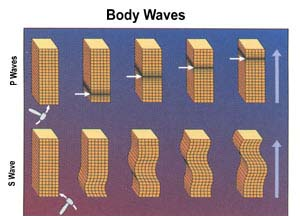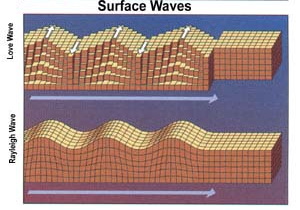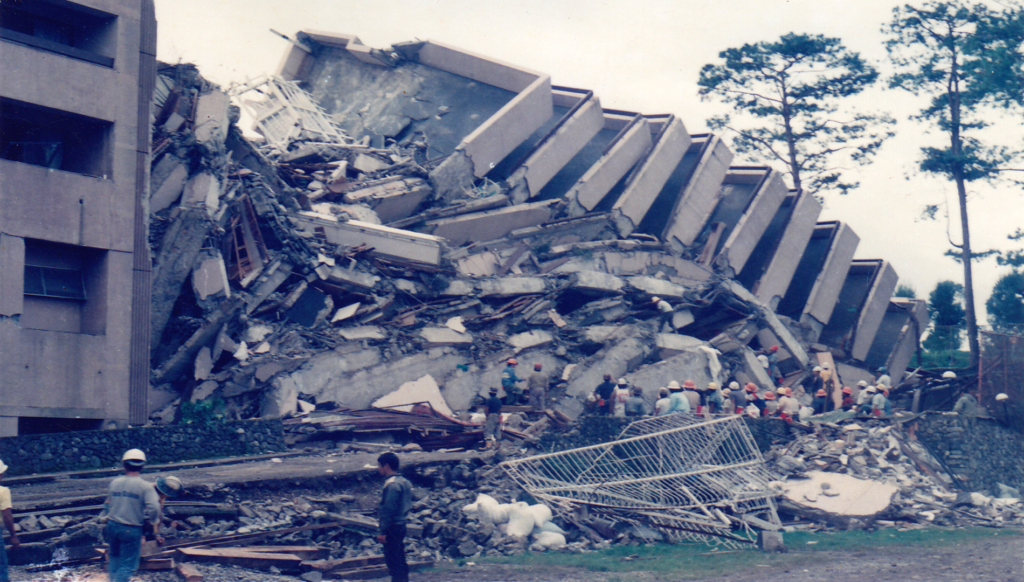
An earthquake is any sudden movement or vibration of the ground as a result of shifts in the Earth’s crust. Tectonic plates that lie underneath the land and oceans make up the surface of our planet. When these plates slip, clash and collide, they release large amounts of energy in the form of seismic waves.
At times, with certain types and features of earthquakes, tectonic activities produce violent, destructive earthquakes that have devastating effects on areas near and far from the earthquake’s source. The majority of these earthquakes occur where large masses of rock move against each other, also known as geologic faults. Our planet’s major fault lines lie at the edges of the massive tectonic plates that make up the Earth’s crust.
An average of 1,000 earthquakes occur on our planet each day. In a year, around 50,000 earthquakes are strong enough to be detected without seismic instruments. Of this number, about 100 of these can produce significant damage in the areas near their centres. Usually, earthquakes of tremendous strength happen only once a year.
Types of Earthquakes
Tectonic
Tectonic earthquakes occur as the result of the breaking of rocks in the earth’s crust. Geological forces acting on plates and rocks cause physical and chemical changes. When rock masses are strained beyond their breaking point, the stress causes sudden fracturing. Fractures in the rock can spread quickly in the same direction and continue for many kilometres.
The tectonic movement found along faults occurs in irregular patterns that suddenly start, stop, and restart. This irregular action is primarily due to rock masses that are forced in different directions but eventually return to positions with less strain on the rock. During this process, seismic waves emanate from the earthquake’s epicentre.
Fault ruptures originate from a place usually 5–15 kilometres below the Earth’s surface. This spot is called the earthquake’s focus. The rupture then spreads over the fault plane in one or two directions until it meets a barrier. At this point, it may either slow down or stop completely. At times, the fault rupture may recommence on the far side or even break the barrier and continue propagating.
Volcanic
Volcanic earthquakes are characterised by a combination of tectonic forces and volcanic activity. Earthquakes of this type may be the outcome of an abrupt slip of rock masses near the volcano, resulting in the release of elastic strain energy. This stored energy may also be partly hydrodynamic, caused by the heat of magma moving inside the volcano’s chamber, or due to the release of pressurised gas.
Along the Pacific Ring of Fire and ocean ridges, there is an evident connection between the distribution of volcanoes and major earthquakes. However, in general, the epicentres of most major earthquakes are found many kilometres away from volcanic vents and volcanoes. The main sources of many earthquakes are rarely situated near active volcanoes.
Earthquakes and volcanism are more likely to be caused by the same tectonic activity rather than be direct causes of each other. An earthquake may even occur directly below a volcanic structure, yet it is more probable that it has no immediate causal relationship with the latter.
Collapse
Minor earthquakes are earthquakes that are felt in mines and underground caverns caused by the explosion of rock on the surface above.
Explosion
Explosion earthquakes are earthquakes caused by the detonation of any powerful artificial explosive device. These explosives may be chemical or nuclear in nature.
Types of Faults

San Andreas Fault
Faults are defined as the fracture or zone of fracture between two slabs of rock. They can be as long as a few millimetres to thousands of kilometres. Faults allow movement to occur between two blocks of rock relative to one another. The slow movement of a fault is called a creep. On the other hand, a fault’s rapid movement is called an earthquake.
In this event, the rock on one side of the fault suddenly slips in relation to the other. The surface of a fault may appear vertically, horizontally, or at some angle in between the two. Geologists classify faults according to their dip – the angle of the fault with respect to the surface – and its direction of slip.
Normal

A normal fault is created when the block above the fault sinks towards the block below. This type of fault falls under dip-slip faults that move along the direction of the dip plane. Normal faults are caused by extension forces that pull the fault’s sides apart. Normal faults are commonly observed along with oceanic ridge systems.
Reverse

A fault is classified as a reverse fault when the hanging wall moves upwards. In this fault type, the upper block above the fault plane moves upwards and is thrust over the lower block. Reverse faults are created by compressional forces that push the sides of the fault together. Faults that belong to this category are often observed in regions where one plate subducts under another.
Transcurrent/Slip-strike Faults

Transcurrent or slip-strike faults move horizontally, with two blocks sliding past each other. These faults are further classified as right-lateral or left-lateral. Right-lateral slip-strike faults are faults, that when viewed from either side, the far block’s displacement is to the right. Conversely, left-lateral slip-strike faults are faults, that when viewed from either side, the far block’s displacement is to the left.
Seismic Waves
Seismic waves are vibrations that travel under the ground or on the Earth’s surface. Seismic waves are created by large dynamic sources such as earthquakes and explosions. There are four principal types of elastic waves that are generated by earthquakes. Among these four types, two are further classified as body waves, and the other two as surface waves. Body waves travel within the earth, while surface waves travel on the Earth’s surface.
Body waves
P-waves
Body waves are classified into two separate types: primary waves and secondary waves. Primary waves or P-waves are the first waves to be produced by an earthquake. Although they are weaker in comparison to S-waves, they travel faster and force the ground up and down in relation to longitude. Body waves stretch and compress the medium through which they travel, similar to sound waves in the air. P-waves travel upwards in curved paths. The speed at which P-waves travel through the earth depends on factors such as rock composition and hydrostatic pressure. In general, P-waves increase in velocity as they travel nearer to the Earth’s core.
S-waves
Secondary waves or S-waves are the body waves that come after the primary waves. They are also called shear waves or transverse waves. S-waves travel at a slower pace through the crust and cause it to move from side to side perpendicular to the direction of the main wave. As S-waves travel through a medium, the medium itself is sheared side-to-side from one direction to another.
Similar to P-waves, S-waves generally experience an increase in velocity as they approach the Earth’s centre. However, they stop as they reach the core’s boundary, as they cannot be transmitted by the liquid core. S-waves are the most destructive form of seismic wave. They also travel upwards in curved paths.
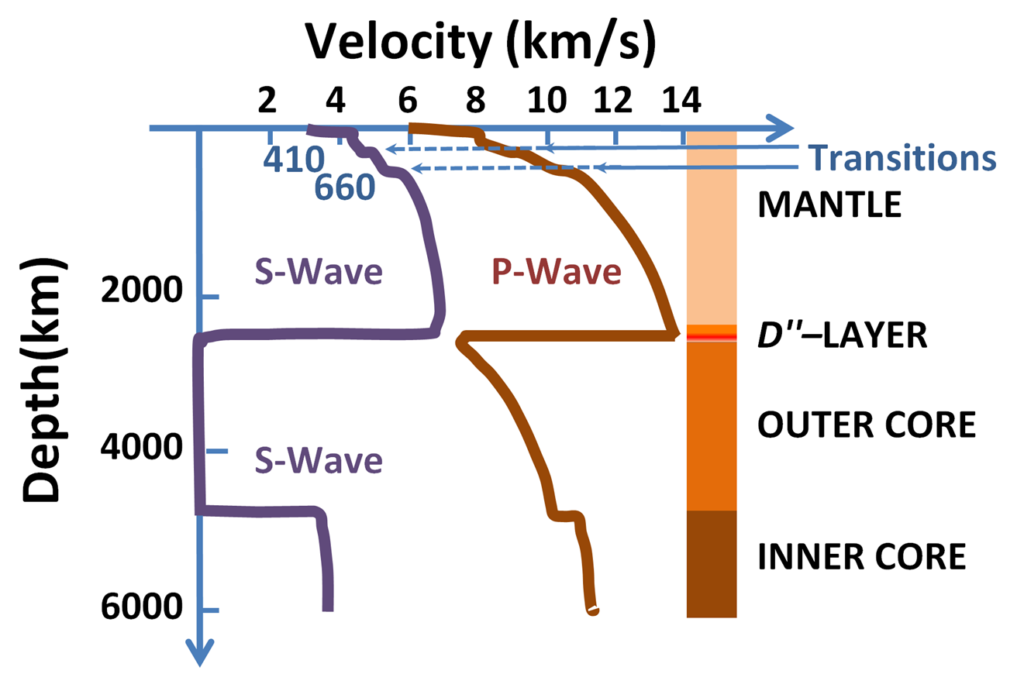
Surface waves
Love waves
Surface waves are waves that travel exclusively on the Earth’s surface. They are further categorised into two: Love waves and Rayleigh waves. Love waves or L-waves are named after A.E.H Love – the British seismologist who first predicted their existence. Love waves travel faster than Rayleigh waves, the second type of surface wave. Love waves propagate on the Earth’s surface when the solid medium nearby varies in elasticity.
These waves have no components in relation to longitude and displace the medium perpendicular to the direction of propagation. Similar to other surface waves, Love waves’ energy emanates from the source in two directions instead of three. This allows these waves to be detected by seismic equipment a great distance from the earthquake source.
Rayleigh waves
Rayleigh waves were named after the British physicist Lord Rayleigh, who was the first person to provide mathematical proof of the existence of these waves. Rayleigh waves travel on the free surface of an elastic solid, such as the Earth’s surface, in a combination of longitudinal dilation and compression. This causes points on the surface to move in an elliptical manner. Rayleigh waves move along the ground similar to the way a wave rolls across the ocean’s surface. The majority of the shaking experienced during an earthquake is due to the great size of these waves. Among all seismic waves, Rayleigh waves have the longest duration.
Intensity and Magnitude
The force of an earthquake may be measured in many ways. However, the terms intensity and magnitude are most commonly used to describe how strong an earthquake is. Both intensity and magnitude each describe a different property of an earthquake.
Earthquake Intensity
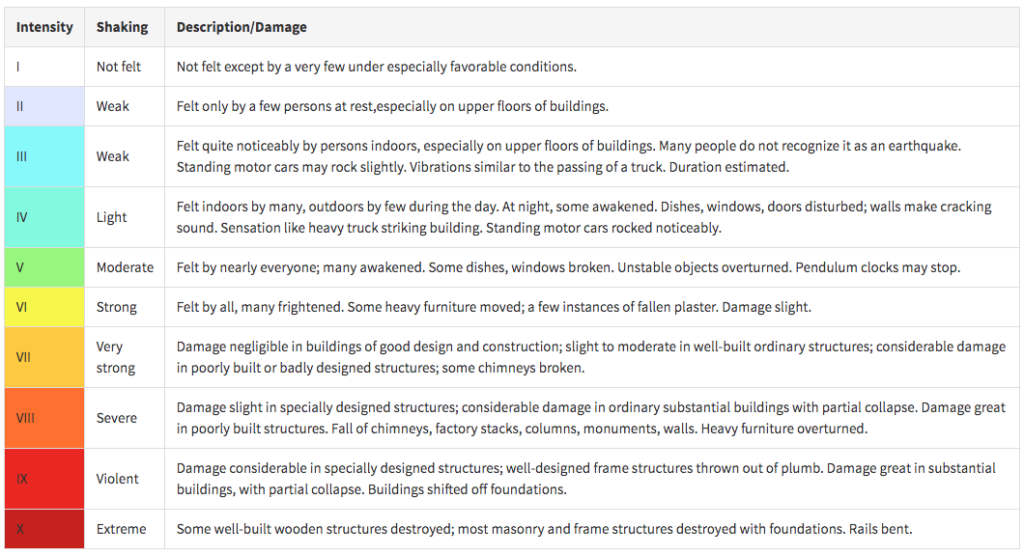
The Modified Mercalli Intensity Scale
Intensity refers to how strong the shaking of an earthquake is in a particular location. An earthquake’s intensity is determined by its effects on human infrastructure, the surrounding environment, and the people and organisms that inhabit it. Intensity depends on a multitude of factors aside from ground acceleration. In a complex manner, an earthquake’s intensity is also reliant on the periods of seismic waves and their other features, the distance of the point of measurement from the source, and the geological features of the local area.
Historically, the strength of an earthquake was measured in qualitative definitions. This is because the shaking that an earthquake produces is not uniform in violence across a single area. Before the development of seismographs, people described an earthquake’s intensity in scales of qualitative measures. However, after the seismograph was invented, intensity scales were then divided according to accurate measurements of the acceleration of ground shaking.
Earthquake Magnitude

Typical Seismograph
Magnitude is the term used to describe the energy that an earthquake releases at its source. Magnitude is the measure of the amplitude or size of the seismic waves produced by an earthquake. The magnitude is measured by instruments known as seismographs.
Earthquakes vary greatly in size. To provide a fair comparison of the sizes of distinct earthquakes, different scales are used at present to accurately measure the magnitude of an earthquake. Arguably the most famous of these scales is the Richter scale, developed by Charles F. Richter in 1935. The Richter scale measures an earthquake’s local magnitude, represented by the letters ML.
Other methods used to measure magnitude include surface-wave magnitude (Ms). This measurement defines magnitude as the logarithm of surface waves’ maximum amplitude or size of ground motion over a 20-second period. Magnitude is also measured according to the amplitude of the P-wave as reflected on a seismograph. This measurement is called the P-wave magnitude (Mb). All magnitude scales yield roughly the same measurements for any given earthquake.
However, the three scales mentioned previously are limited specifically in application and range. These scales fail to accurately measure the size of larger earthquakes. Thus, a different scale is used to measure an earthquake’s magnitude with regard to its seismic moment. The moment magnitude (Mw) is proportional to the logarithm of an earthquake’s seismic moment.
This measure of magnitude is much more difficult to compute than all other scales of magnitude; however, it has the widest range of applications and can measure the sizes of all earthquakes. For the magnitudes of moderately sized earthquakes, its values do not stray far from those measured according to the surface-wave magnitude or Ms.
Frequently Asked Questions
What is the difference between an earthquake’s focus and epicentre?
The focus of an earthquake refers to the exact point within the Earth where the seismic energy is released, while the epicentre is the location on the Earth’s surface directly above the focus.
What are the primary types of seismic waves generated by earthquakes?
The primary types of seismic waves generated by earthquakes are P-waves (primary waves), S-waves (secondary waves), and surface waves. P-waves and S-waves are body waves that travel through the Earth’s interior, while surface waves travel along the Earth’s surface.
What is a foreshock and an aftershock?
A foreshock is a smaller earthquake that precedes the main shock and occurs in the same area. An aftershock, on the other hand, is a series of smaller earthquakes that follow the main shock, often for days or weeks.
What is a seismograph used for?
A seismograph is an instrument used to detect and record seismic waves caused by earthquakes. It measures the amplitude and frequency of the waves, allowing scientists to analyze the characteristics of the earthquake.
Can earthquakes trigger other natural disasters?
Yes, earthquakes can trigger other natural disasters such as tsunamis, landslides, and even volcanic eruptions. The shaking of the ground during an earthquake can cause significant disturbances in the surrounding environment.
References
Causes and characteristics of Earthquakes. (n.d.). Retrieved from Cool Geography: https://www.coolgeography.co.uk/A-level/AQA/Year%2013/Plate%20Tectonics/Earthquakes/Causes%20&%20Characteristics.htm
Earthquake. (n.d.). Retrieved from Britannica: https://www.britannica.com/science/earthquake-geology/Tectonics
Earthquake. (n.d.). Retrieved from National Geographic: https://www.nationalgeographic.org/topics/resource-library-earthquake/?q=&page=1&per_page=25
Earthquake Basics. (n.d.). Retrieved from South California Earthquake Center: http://scecinfo.usc.edu/eqcountry/roots/basics.html
Magnitude. (n.d.). Retrieved from USGS: https://earthquake.usgs.gov/learn/glossary/?term=magnitude
Reading: Magnitude versus Intensity. (n.d.). Retrieved from Lumen Learning: https://courses.lumenlearning.com/geo/chapter/reading-magnitude-versus-intensity/
Seismic Wave. (n.d.). Retrieved from Britannica: https://www.britannica.com/science/seismic-wave
Types of Earthquakes and Faults. (n.d.). Retrieved from people.uwec.edu: https://people.uwec.edu/jolhm/eh/toivonen/types.htm#:~:text=There%20are%20four%20different%20types,cause%20physical%20and%20chemical%20changes
What is a fault and what are the different types?. (n.d.). Retrieved from USGS: https://www.usgs.gov/faqs/what-a-fault-and-what-are-different-types?qt-news_science_products=0#qt-news_science_products
What Is Seismology?. (n.d.). Retrieved from Michigan Tech: http://www.geo.mtu.edu/UPSeis/waves.html






